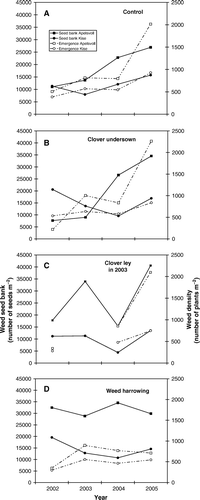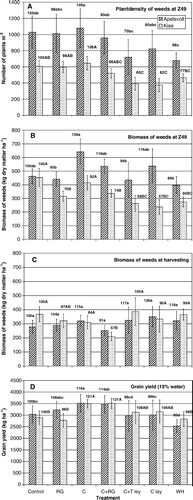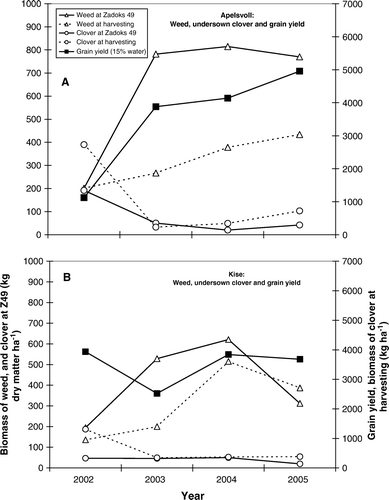Figures & data
Table I. A summary of the treatments in the field experiments at Apelsvoll and Kise (RC = red clover, WC = white clover, T = timothy, RG = ryegrass, WH = weed harrowing).
Table II. Dates of management and sampling operations.
Table III. Monthly mean precipitation and temperature at the experiment sites.
Figure 1. Effect on weed seed bank to 0.20 m soil depth (left y-axis) and emergence of weeds in the field at Zadoks 49 (right y-axis) in control plots without clover undersowing (A), with clover undersowing (B), with clover ley (C) and with weed harrowing (D) at Apelsvoll and Kise.

Figure 2. Average across all years of emerged number of weeds at Zadoks 49 (A), weed biomass at Zadoks 49 (B), weed biomass at harvest (C) and grain yield (D) with control treatment, undersown ryegrass (RG), undersown clover (C), undersown clover and ryegrass (C + RG), clover and timothy (C + T ley), clover ley (C ley) and weed harrowing (WH) at Apelsvoll and Kise compared with control (100%) at the two experimental sites. Columns with same letters (lower case: Apelsvoll; upper case: Kise) are not significantly different (p<0.05). Bars indicate±SE (n = 16).

Table IV. Soil seed bank (number of seeds m−2) down to 0.20 cm depth. The first 20 species are annual, the last three species are perennial. Unidentified + clovers are not counted in the number of species, but are included in the sum of all species. Sums with same letter (Apelsvoll: lower case; Kise: upper case) are not significantly different at p ≤ 0.05 (n = 16).
Table V. Weed emergence (number of plants m−2) in fields with seed bank analysis. The first 24 species are annual, the last 9 species are perennial. Unidentified, clovers and Brassica spp. are not counted in the number of species, but are included in the sum of all species. 0 = mean value between 0 and 0.5,− = not observed. Sums with same letter (Apelsvoll: lower case; Kise: upper case) are not significantly different at p ≤ 0.05 (n = 16). 0 = mean values between 0 and 0.5.− = not detected.
Table VI. Pearson correlation coefficients (r) for weed data 2002–2005 (n = 16). *: p ≤ 0.05; **: p ≤ 0.01; ***: p ≤ 0.001; n.s.: not significant.
Figure 3. Biomass of weed and clover at Zadoks 49, and grain yield and biomass of clover at harvesting, at Apelsvoll (A) and Kise (B).
